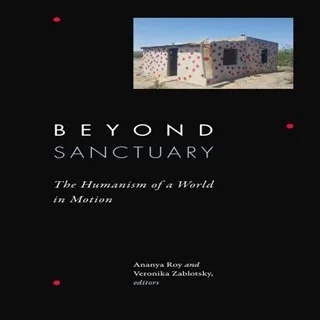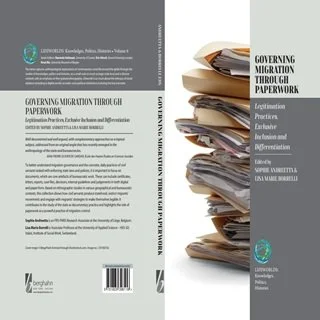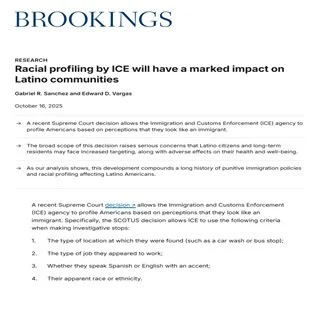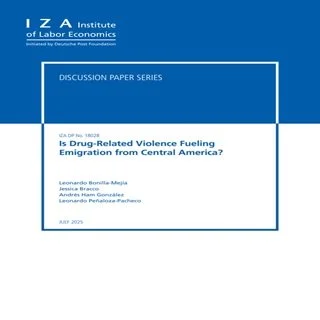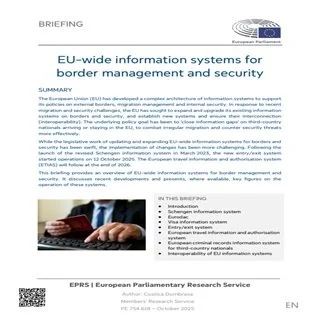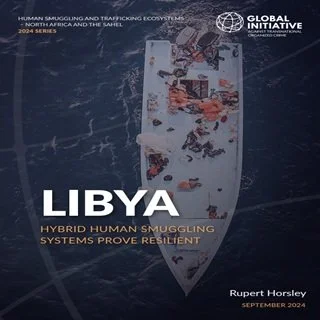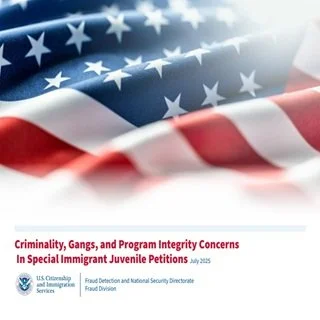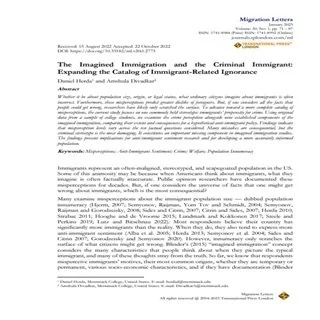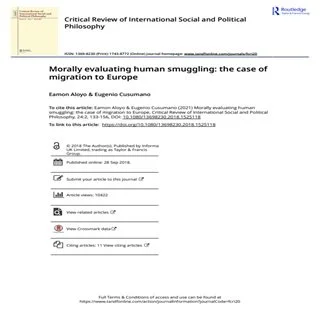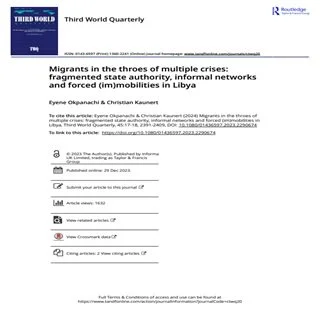Editors: Andreetta, Sophie and Borrelli, Lisa Marie
To better understand migration governance and the concrete, daily practices of civil servants tasked with enforcing state laws and policies, it is important to focus on documents, which are core artefacts of bureaucratic work. These can include certificates, letters, reports, case files, decisions, internal guidelines and judgements in both digital and paper form. Based on ethnographic studies in various geographical and bureaucratic contexts, this collection shows how civil servants produce statehood, restrict migrants’ movements and engage with migrants’ strategies to make themselves legible. It contributes to the study of the state as documentary practice and highlights the role of paperwork as a powerful practice of migration control.
Oxford, UK: New York: Berghahn Books, 2025.
By Gabriel R. Sanchez and Edward D. Vargas
A recent Supreme Court decision allows the Immigration and Customs Enforcement (ICE) agency to profile Americans based on perceptions that they look like an immigrant.
The broad scope of this decision raises serious concerns that Latino citizens and long-term residents may face increased targeting, along with adverse effects on their health and well-being.
As our analysis shows, this development compounds a long history of punitive immigration policies and racial profiling affecting Latino Americans.
The broad parameters established for being susceptible to ICE investigations put a large number of Latino citizens in jeopardy of being targeted, despite not being undocumented. For example, with an estimated 75% of Latinos across the country reporting that they can speak Spanish pretty well or very well, a large number of Latino citizens are likely to be questioned due to their potential to be perceived as speaking with an accent. When we asked a national sample of Latino immigrants about the accents in their speech patterns, 22% of Latino naturalized citizens reported that they had been discriminated against in their daily activities for speaking with an accent. Clearly, the use of language as a profiling tactic will lead to Latino citizens being unduly questioned and detained.
Similarly, although it is challenging to determine how race or ethnicity might be perceived as a marker for immigration status, our national survey of Latino immigrants strongly suggests that many Latino citizens will be vulnerable to these criteria. In fact, we asked respondents directly what a white border patrol agent whom they might encounter would assume their race to be, based on their skin color, hairstyle, or facial features. Nearly half (48%) of naturalized Latino citizens reported they would be defined as Latino/Hispanic, and 19% said they would be defined as Mexican. Furthermore, 60% of naturalized citizens reported that their skin color is “medium, dark, or very dark” in our self-reported measure of skin color. These Latino citizens would be highly likely to be targeted under the profiling criteria permitted by the Supreme Court’s ruling.
As we discuss in this post, this decision will have a marked impact on Latino Americans—a community that has long been targeted by punitive immigration policies and, as prior research suggests, has already been harmed by racial profiling tied to immigration enforcement.
We have studied the implications of profiling based on immigration status for some time, employing survey measures to better understand how external perceptions of being foreign-born impact Latino Americans.
Washington, DC: Brookings Institution, 2025
By Emily Ryo, Jennifer M. Chacón, and Cecilia Menjívar
This article presents a critical analysis of social scientific research from the past fifteen years on the criminalization of immigration in the United States. Our review reveals three central themes. First, although immigration law is considered federal civil law, immigration enforcement has become substantially intertwined with criminal law enforcement in ways that have broad-ranging and radiating effects on immigrant communities of color. Second, race plays an important bidirectional role in the increasing criminalization of immigration. Specifically, criminalizing immigration results in the racialization of certain immigrant groups as dangerous outsiders, and such racialization has the effect of sustaining and promoting the policies and practices that target or have a disproportionate impact on certain immigrant groups. Third, given the increased externalization of US immigration enforcement programs, the effects of the criminalization of immigration are not limited to the United States. Each of these dynamics operates across multiple sites and in various components of the immigration enforcement system to disproportionately affect immigrants racialized as non-White in the United States. We discuss the important gaps in research and policy implications that follow from our review
RSF: The Russell Sage Foundation Journal of the Social Sciences 11(3): 282–343.
By Leonardo Bonilla-Mejía, Jessica Bracco, Andres Ham Gonzalez, Leonardo Peñaloza-Pacheco:
We study how drug-related violence affects emigration from Central America, a region with rapidly rising migration to the United States. Using multiple data sources, we apply an instrumental variables strategy based on proximity to drug-trafficking routes and coca production in Colombia. We find that violence significantly increases intentions, plans, and preparations to emigrate—especially to the U.S.—with stronger effects among young and high-skilled individuals. Mediation analysis suggests this response is driven by declining economic activity and, more importantly, deteriorating labor market conditions caused by escalating violence.
IZA DP No. 18028 Bonn: ZA – Institute of Labor Economics, 2025. 74p.
By Costica Dumbrava
The European Union (EU) has developed a complex architecture of information systems to support its policies on external borders, migration management and internal security. In response to recent migration and security challenges, the EU has sought to expand and upgrade its existing information systems on borders and security, and establish new systems and ensure their interconnection (interoperability). The underlying policy goal has been to 'close information gaps' on third-country nationals arriving or staying in the EU, to combat irregular migration and counter security threats more effectively. While the legislative work of updating and expanding EU-wide information systems for borders and security has been swift, the implementation of changes has been more challenging. Following the launch of the revised Schengen information system in March 2023, the new entry/exit system started operations on 12 October 2025. The European travel information and authorisation system (ETIAS) will follow at the end of 2026. This briefing provides an overview of EU-wide information systems for border management and security. It discusses recent developments and presents, where available, key figures on the operation of these systems.
Brussels: EPRS | European Parliamentary Research Service, 2025.. 12p.
By Laura Huttunen
This article suggests a conceptual framework to think about migrant disappearances. It argues that juxtaposing them with disappearances in other contexts, such as armed conflicts and totalitarian regimes, makes it possible to understand the specificities of each context. The suggested conceptual framework approaches missing and disappeared people as members of families and local communities, but also as subjects of state power and systems of governance across the globe. Migrant disappearances are framed within the tightening border regimes between the Global North and the Global South, and huge global inequalities. The article maps the specificities of migrant disappearances and the challenges of the reconnecting work of search and forensic identification in the context of irregular or undocumented migration. It argues that migrant disappearances often result from migrants being exposed to dangerous circumstances and being left unprotected by any state. The uncertainties and agonies as well as practical and judicial problems faced by families and communities left behind are foregrounded. Moreover, it argues for attention to be paid to various forms of symbolic ‘reappearances’, such as memorial practices and political activism. It also argues that there is a need for more empirical data and theoretical understanding of the complexities of migrant disappearances and reappearances across the globe, both at a global systemic level and in the multiple localities touched by disappeared community members.
Journal of Disappearance Studies, 1(1), 75-93. Retrieved Oct 6, 2025,
By Kelly Bescherer, Stephan Scheel
The capacity to establish migrants' legal identities is key to states' attempts to control access to their territories. This paper introduces the concept of regimes of proof to shed light on this often-neglected aspect of border and migration control and related migrant struggles. Negotiations around legal identities play a central role in deportation, but also in migrants' access to rights and government services. At the current conjuncture, this tension has become particularly relevant: new digital means of identification such as biometric residency cards or the analysis of mobile phone data are rapidly being introduced across the globe to establish and fix migrants' identities and to determine their country of origin. Drawing on ethnographic research in West Africa and Germany, we consider the implications of shifting regimes of proof in the context of asylum, deportation and regularisation procedures to highlight the centrality of identification to all aspects of migration management.
International MigrationVolume 63, Issue 6 Nov 2025
By Rupert Horsley
Human smuggling across these regions continues to evolve rapidly. Since the COVID-19 pandemic, significant changes have emerged in the volume and direction of migratory flows and smuggling networks. These shifts are closely linked to ongoing political, economic and security developments, including protracted conflict, governance crises and economic uncertainty.
Since 2016, the GI-TOC has monitored the political economy of human smuggling and trafficking in North Africa and the Sahel. This work was expanded and formalised in 2018 with the establishment of the North Africa and Sahel Observatory (NAS-Obs). Through annual country reports and thematic studies, the Observatory has provided a detailed understanding of the actors, routes and dynamics shaping mobility and exploitation in the region.
The 2025 series features country reports on Libya, Niger, Chad and Tunisia. Together, they capture the current transformations in human smuggling across both regions: from the persistence of hybrid smuggling systems in Libya, to evolving migration routes through Niger and Chad, and the increasing mobility of Sudanese refugees across North Africa. The reports also analyse the political and security contexts driving these trends, including the deepening conflict in Sudan, ongoing instability in Libya, and growing pressures along Tunisia’s coastal migration routes.
Geneva: Global Initiative Against Transnational Organized Crime, . 2025. 36p.
By Jeffrey Lesser
Jeffrey Lesser focuses on São Paulo’s Bom Retiro neighborhood to examine the competing visions of wellbeing in Brazil among racialized immigrants and policymakers and health officials.
There is a saying in Brazil: “Mosquitoes are democratic: they bite the rich and the poor alike.” Why then is bad health---from violence to respiratory disease, from malaria to dengue---dispersed unevenly across different social and national groups? In Living and Dying in São Paulo, Jeffrey Lesser focuses on the Bom Retiro neighborhood to explore such questions by examining the competing visions of well-being in Brazil among racialized immigrants and policymakers and health officials. He analyzes the fraught relationship between Bom Retiro residents and the state and health care agencies that have overseen community sanitation efforts since the mid-nineteenth century, drawing out the connected systems of the built environment, public health laws and practices, and citizenship. Lesser employs the concept of “residues” to outline how continuing historical material, legislative, and social legacies structure contemporary daily life and health outcomes in the neighborhood. In so doing, Lesser creates a dialogue between the past and the present, showing how the relationship between culture and disease is both layered and interconnected.
Durham, NC: Duke University Press, 2025.
By The U.S. Citizenship and Immigration Services
Hundreds of gang members, murderers, and sex offenders exploited a vulnerability in America’s immigration systemWASHINGTON – Today U.S. Citizenship and Immigration Services published a report identifying significant national security and integrity vulnerabilities in the Special Immigrant Juvenile program. These national security vulnerabilities provided a path to lawful permanent residence and eventually citizenship to criminal aliens, gang members, and known or suspected terrorists.The “Criminality, Gangs, and Program Integrity Concerns in Special Immigrant Juvenile Petitions” report reviews over 300,000 aliens’ SIJ petitions filed from the beginning of fiscal year 2013 through February 2025. According to the report:More than half of SIJ petitioners filing in FY 2024 were over age 18;Many entered the United States without inspection;Many came from countries identified as posing national security concerns, demonstrating the lax screening and vetting and anti-fraud policies of the Biden Administration; andSome SIJ petitioners engaged in age and identity fraud, including falsifying their name, date of birth, and country of citizenship.The report also identified 853 known or suspected gang members who filed SIJ petitions, most of which were approved. More than 600 MS-13 gang members filed SIJ petitions, and more than 500 were approved. MS-13 gang member SIJ petitioners include at least 70 charged with federal racketeering offenses and many others charged with violent crimes in the United States. Other approved gang members include more than 100 known or suspected members of the 18th Street gang; at least three Tren de Aragua gang members; and dozens of Sureños and Norteños gang members.“Criminal aliens are infiltrating the U.S. through a program meant to protect abused, neglected, or abandoned alien children,” said USCIS Spokesman Matthew J. Tragesser. “This report exposes how the open border lobby and activist judges are exploiting loopholes in the name of aiding helpless children.”On June 6, USCIS rescinded the policy of categorically considering deferred action for special immigrant juveniles. The Trump administration also is exploring further action to mitigate vulnerabilities in the integrity of the SIJ program, address significant national security and public safety concerns, and ensure the SIJ classification remains available for the juveniles it was intended to protect.Congress first established the SIJ program in 1990 and has amended it several times to allow young illegal aliens, whom a juvenile court has determined cannot reunify with one or both parents due to abuse, neglect, or abandonment, to apply for SIJ classification and lawful permanent resident status and have an eventual path to U.S. citizenship. By law, there are no criminal bars or good moral character requirements for SIJ petition approval.
Washington, DC: U.S. Citizenship and Immigration Services, 2025. 36p.
By Travis J. Masters, Rebecca Gambler
CBP relied on contracts to operate and maintain soft-sided facilities (SSF). These facilities provide support and services when additional processing and holding capacity is needed for individuals apprehended along the southwest border. DHS also received funding to construct Joint Processing Centers (JPC)—permanent facilities that DHS expects will be more cost-effective than SSFs in the future. GAO was asked to review CBP’s and DHS’s use and oversight of SSFs and JPCs. This report examines, among other things, (1) how CBP used contracts to support its SSF needs, and (2) the extent to which CBP and DHS engaged in planning efforts for SSF and JPC related acquisitions. GAO analyzed contracting data on SSF contract obligations for fiscal years 2019-2024, and reviewed DHS budget plans, acquisition policies, and cost estimates for SSFs and JPCs. GAO also visited four selected SSF locations in Yuma and Tucson, AZ, El Paso, TX, and San Diego, CA based in part on apprehension and cost data; reviewed a nongeneralizable sample of eight of 69 contracts for SSFs and JPC construction contract documents; and interviewed DHS and CBP officials. What GAO Recommends GAO is making six recommendations, including that CBP identifies and documents lessons learned from its SSF acquisitions; and that DHS documents its process for identifying future JPC locations and completes a life-cycle cost estimate for the Laredo JPC. DHS concurred with the recommendations
Washington, DC: United States Government Accountability Office - GAO, 2025. 64p
By Daniel Herda and Amshula Divadkar
Whether it be about population size, origin, or legal status, what ordinary citizens imagine about immigrants is often incorrect. Furthermore, these misperceptions predict greater dislike of foreigners. But, if one considers all the facts that people could get wrong, researchers have likely only scratched the surface. To advance toward a more complete catalog of misperceptions, the current study focuses on one commonly held stereotype: immigrants’ propensity for crime. Using original data from a sample of college students, we examine the crime perception alongside nine established components of the imagined immigration, comparing their extent and consequences for a hypothetical anti-immigrant policy. Findings indicate that misperception levels vary across the ten factual questions considered. Many mistakes are consequential, but the criminal stereotype is the most damaging. It constitutes an important missing component in imagined immigration studies. The findings present implications for anti-immigrant sentiment research and for developing a more accurately informed population.
Migration Letters, 20(1), 71–87
By Ximena Canal Laiton
This report examines the experiences of migrant women in transit in South America. It is based on 4Mi1 surveys and interviews with migrant women and key informants conducted in Peru, Chile, Argentina, Bolivia, Uruguay, Colombia, and Brazil between December 2024 and May 2025. Addressing the lack of information on women’s experience of migration in the region, this report presents findings on risks, sexual and reproductive health issues, the gender-based division of labour, mechanisms and barriers to self-protection, access to assistance, and the needs of migrant women in transit. The report provides empirical evidence to inform decision-makers and humanitarian actors. Key findings • Women are consistently affected by the general risks of migration routes in South America, in particular mentioning theft, extortion, bribery, and verbal violence. In addition, this research identified specific risks of sexual violence for women in transit, such as abuse and exploitation, which may go unnoticed by many migrant women despite being flagged by key informants. • The adverse conditions of migration have a major impact on the sexual and reproductive health of some women. During the journey, pregnancy, breastfeeding, and menstruation often occur in inadequate circumstances, which increases the health risks for women or their babies, born or to be born, including morbidity, mortality, low birth weight, malnutrition, vaginal infections, and toxic shock syndrome, among others. • Constant stress, the uncertainty of migration, migratory grief, and other related factors negatively impact women’s mental health during migration. The data shows that migrant women experience feelings of sadness, frustration, fear, and guilt. • Women adopt various self-protection strategies to cope with the dangers of the journey. The main measures include staying in touch with family, planning the journey, and travelling with companions. While emotional care strategies exist, the women interviewed reported using very few and revealed a persistent lack of tools to manage emotional challenges. • The gender-based division of labour persists during migration, with women being assigned domestic and care tasks. Women are primarily responsible for caring for children and other dependents, as well as organising meals and groceries for the travel group. • Despite the meaningful humanitarian response along migration routes in South America, these services still need to be strengthened. Almost half of the women respondents reported not receiving assistance during their journey, while most stated that they had unmet needs at the time of the survey, mainly needing cash, accommodation, and medical care.
London: Mixed Migration Centre, 2025. 28p.
By Bail for Immigration Detainees -
The Legal Aid, Sentencing and Punishment of Offenders Act (“LASPO”) took most immigration cases out of scope of legal aid. However, Exceptional Case Funding (“ECF”) was introduced as a ‘safety net’ for people whose cases fell out of the scope of legal aid but whose exclusion would result in breaches of their human rights. This report explored the hurdles of applying for ECF and then finding a legal aid lawyer for people facing deportation and those whose claims to remain in the UK were based on Article 8 (private & family life) of the Human Rights Act.
The Legal Aid, Sentencing and Punishment of Offenders Act (“LASPO”) took most immigration cases out of scope of legal aid. However, Exceptional Case Funding (“ECF”) was introduced as a ‘safety net’ for people whose cases fell out of the scope of legal aid but whose exclusion would result in breaches of their human rights. This report explored the hurdles of applying for ECF and then finding a legal aid lawyer for people facing deportation and those whose claims to remain in the UK were based on Article 8 (private & family life) of the Human Rights Act.
London: BiD, 2025. 41p.
By Galya Ben-Arieh and Volker M. Heins
This article explores the emergence of the crime of migrant smuggling and its legitimising narratives as tools of global migration management. We examine the ways in which the language of ‘migrant smuggling’ was introduced into and then lifted out of the context of international law and recontextualised to serve the purposes of migration management. The main consequence of this fusion of law, narrative, and policy is the definition of the legality of actors and actions along the migration routes across the Sahara, the Mediterranean and Europe. We examine the conflict between two dominant narratives of legality: the smugglers’ narrative vs the rescue narrative. Laws designed to protect people are being turned against the people they were ostensibly designed to protect. We argue that the smuggler narrative facilitates policies whereby wealthy states, under the pretence of law, contain migration from the South within the broader framework of a divisive global politics of life. Since these policies are implemented through bribery, blackmail, and brute force, they are displaying the ugly face of global migration governance without contributing in any way to a solution of the problems driving migration in the current global environment
Third World Quarterly 2021, Vol. 42, No. 1, 200–217Criminalisation of kindness: narratives of legality in the European politics of migration containmentGalya Ben-Arieh a and Volker M. Heins
By Eamon Aloyo & Eugenio Cusumano
Much of the recent debate on immigration to Europe has focused on how many refugees should be allowed to enter and how refugees should be distributed among EU member states, but there has been less academic focus on under what conditions, if any, human smuggling is morally permissible. How should we morally assess those who make a business out of helping migrants reach their desired destination and those who pay smugglers to reach their destination? We argue that human smuggling is morally permissible under some conditions even if it is illegal. Human trafficking, by contrast, is immoral and should be illegal. The moral conditions for permissible human smuggling are sometimes being met on the route from Africa to Europe (but are all too often grossly violated). We consider and rebut objections based on the arguments that a legal prohibition on human smuggling must translate into a moral one, and that human smuggling violates the rights of individuals to freedom of association in receiving countries. We conclude with policy implications
Critical Review of International Social and Political Philosophy, 24(2), 133–156.
By Corey Robinson
Using an analytic of problematisation that incorporates insights from governmentality studies and migration studies, this article documents and conceptualises the role of capacity building in the offshoring and outsourcing of Canada’s anti-smuggling policy. I examine the problematisation of migrant smuggling in interviews, access to information requests and publicly available texts to show how, why and with what effects, the Canadian government, in collaboration with UN agencies, engaged in capacity building across Southeast Asia and West Africa to combat migrant smuggling and interdict migrant vessels before they departed for Canada. I argue that under the technocratic banner of capacity building, anti-smuggling policy constitutes migrant smuggling as an object of discourse. Anti-smuggling policy, I contend, frames, rationalises and obscures the interdiction of refugees and the externalisation of protection as politically neutral, technocratic efforts to build capacity to combat migrant smuggling. Though capacity building may include apparently positive measures to enhance international cooperation, if it frustrates access to asylum, as this article suggests, it can be said to externalise international protection responsibilities, contrary to the principles outlined in the Global Compact for Safe, Orderly and Regular Migration and the Global Compact on Refugees.
Geopolitics, 29(1), 13–38
By Corey Robinson
Offering return assistance and financial inducements to migrants and asylum-seekers, assisted voluntary return and reintegration (AVRR) programmes are critical to the management of migration. While AVRR programmes have emerged as an area of study in their own right, little attention has been paid to the role of these schemes in the transnational politics of anti-smuggling policy. Building on insights from border studies, migration studies and security studies, this article examines the Global Assistance for Irregular Migrants (GAIM) programme. The GAIM programme is an AVRR programme funded by the Canadian government and implemented by the International Organization for Migration (IOM), which targeted Sri Lankan nationals stranded following the disruption of smuggling ventures in West Africa. This article examines how the GAIM programme framed, rationalised and obscured the practice of neoliberal deportation as a humanitarian gesture in the interests of migrants themselves. It documents and conceptualises the humanitarian claims, narratives and representations mobilised by Canada and the IOM to explain and justify the return of stranded asylum-seekers. It argues that the GAIM programme can be analysed as a form of humanitarian securitisation, which obscures the politics of anti-smuggling policy, masks the violence of deportation and legitimises the return of stranded asylum-seekers.
Third World Quarterly Volume 43, 2022 - Issue 4
By Eyene Okpanachi & Christian Kaunert
This article investigates the influence of non-state actors’ activities on migrants’ journeys and the resulting phenomena of ‘stranded migrants’ and forced (im)mobilities in Libya. Due to the intense instability in Libya in the post-Gaddafi era and increasing restrictions on EU borders, return migration became a major plank of the EU’s migration policy. The article examines the distinct nature of the European Union’s externalisation policies and practices regarding migration. Specifically, it explores how these policies, when implemented in politically unstable contexts such as Libya, involve armed actors (or militias) who enforce immigration control through the use of violence against migrants. As a result of these practices, distinct dynamics of multi-level governance (MLG) have emerged, in which informal non-state actors play leading roles in the complicated nexus between informality and formality, making migration to Europe and the return of stranded migrants to their home countries difficult.
Third World Quarterly, Volume 45, 2024 - Issue 17-18


